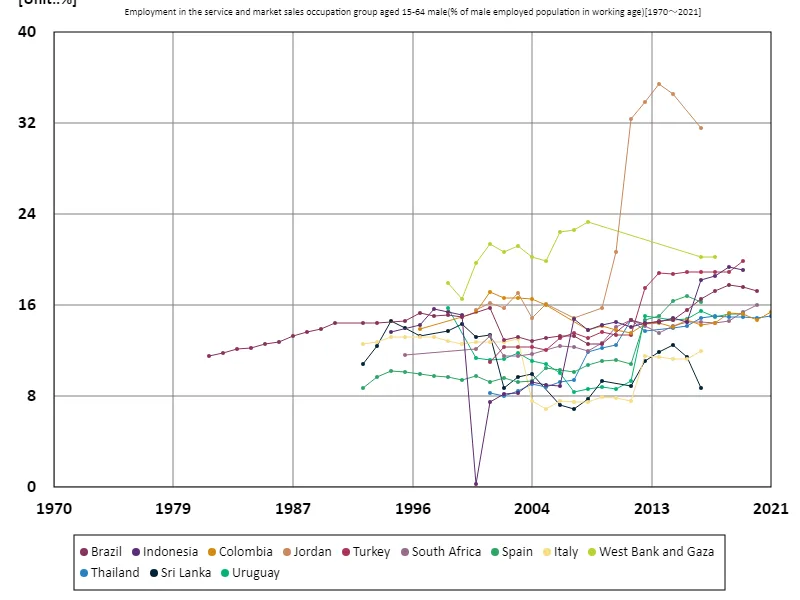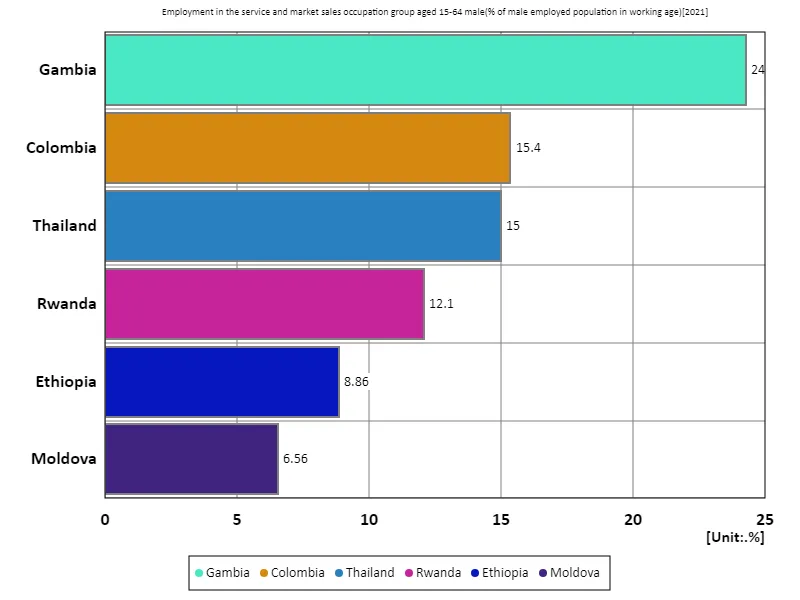- Abstract
- Employment rate for men aged 15-64 in the service and marketing sectors (percentage of working-age males in the workforce)
- Employment rate for men aged 15-64 in the service and marketing sectors (percentage of working-age males in the labour force) (Worldwide)
- Employment rate for men aged 15-64 in the service and marketing sectors (percentage of working-age males in the labour force) (Worldwide, latest year)
- Reference
Abstract
Data for 2021 shows that Colombia has the highest employment rate in the service and market sales sector for men aged 15-64, at 15.4%. This high employment rate reflects the unique characteristics of the Colombian economy. Specifically, the informal sector plays a large role in Colombia, with many people working in the service and marketing sectors. While this provides employment flexibility and is expected to reduce unemployment, it can also raise questions about working conditions and stability. Furthermore, Colombia is one of the Latin American countries experiencing rapid economic development and population growth, resulting in rapid demand in the service and marketing sectors. This trend is closely linked to increasing urbanization and consumer demand, which in turn boosts commercial activity and creates employment opportunities. However, the expansion of the informal sector also comes with several challenges, including income insecurity and lack of social protection. Overall, Colombia’s high employment rate can be seen as part of economic growth, but the healthy development of the labour market requires continued improvement.
Employment rate for men aged 15-64 in the service and marketing sectors (percentage of working-age males in the workforce)
Looking at data from 1981 to 2021, Jordan saw its employment rate in the service and market sales sector for men aged 15-64 peak in 2013 at 35.4%, but now stands at 89% of that peak. This fluctuation reflects the changing structure of Jordan’s economy. The high peak employment rate was underpinned by rapid urbanization and the expansion of the service sector, but the subsequent decline is due to a variety of factors. This may be due to changes in the economy, increased competition both within and outside the region, or shifts in economic policy. For example, as more employment has shifted to the informal sector, there may have been fewer stable employment opportunities, contributing to a decline in overall employment rates. Another factor is the ongoing changes in industrial structure due to globalization and technological innovation. Fluctuations in employment rates in Jordan’s service and market sectors point to challenges to the healthy development of the economy and building a stable employment environment, and future policy adjustments will be important.


The maximum is 35.4%[2013] of Jordan, and the current value is about 89%
Employment rate for men aged 15-64 in the service and marketing sectors (percentage of working-age males in the labour force) (Worldwide)
Looking at data from 1981 to 2021, Jordan’s employment rate in the service and market sales sector for men aged 15-64 peaked at 35.4% in 2013, but now stands at 89% of that peak. This decline is due to several economic and social factors. The high peak employment rate reflected rapid urbanization and the booming service sector. However, the current decline is likely due to structural changes in the economy, such as the expansion of the informal sector and economic instability. Regional political instability and global economic changes may also have affected Jordan’s job market. Recent economic policy changes and technological advances will also contribute to employment trends in the service and marketing sectors. These factors present new challenges regarding job quality and stability and will be important considerations for future economic strategies.


The maximum is 35.4%[2013] of Jordan, and the current value is about 89%
Employment rate for men aged 15-64 in the service and marketing sectors (percentage of working-age males in the labour force) (Worldwide, latest year)
According to 2021 data, the employment rate in the service and market sales sector for men aged 15-64 is highest in The Gambia at 24.3%, compared to an overall average of 13.7% and a total of 82.2%. This figure reflects differences in employment characteristics and economic structures across regions. The Gambia’s high employment rate indicates that much of the economy relies on the informal sector, with services and market sales being important sources of employment. Especially in developing countries, these sectors generate significant employment and support economic flexibility. On the other hand, with the overall average at 13.7%, developed countries and other regions tend to have relatively low employment rates in the service and marketing sectors due to industrial diversification and economic maturity. The combined figure of 82.2% indicates that the services and marketing sector remains the leading source of employment worldwide. However, regional disparities and differences in economic development have a significant impact on employment rates, indicating that employment in these fields is closely related to regional economic strategies and policies.


The maximum is 24.3% of Gambia, the average is 13.7%, and the total is 82.2%



Comments